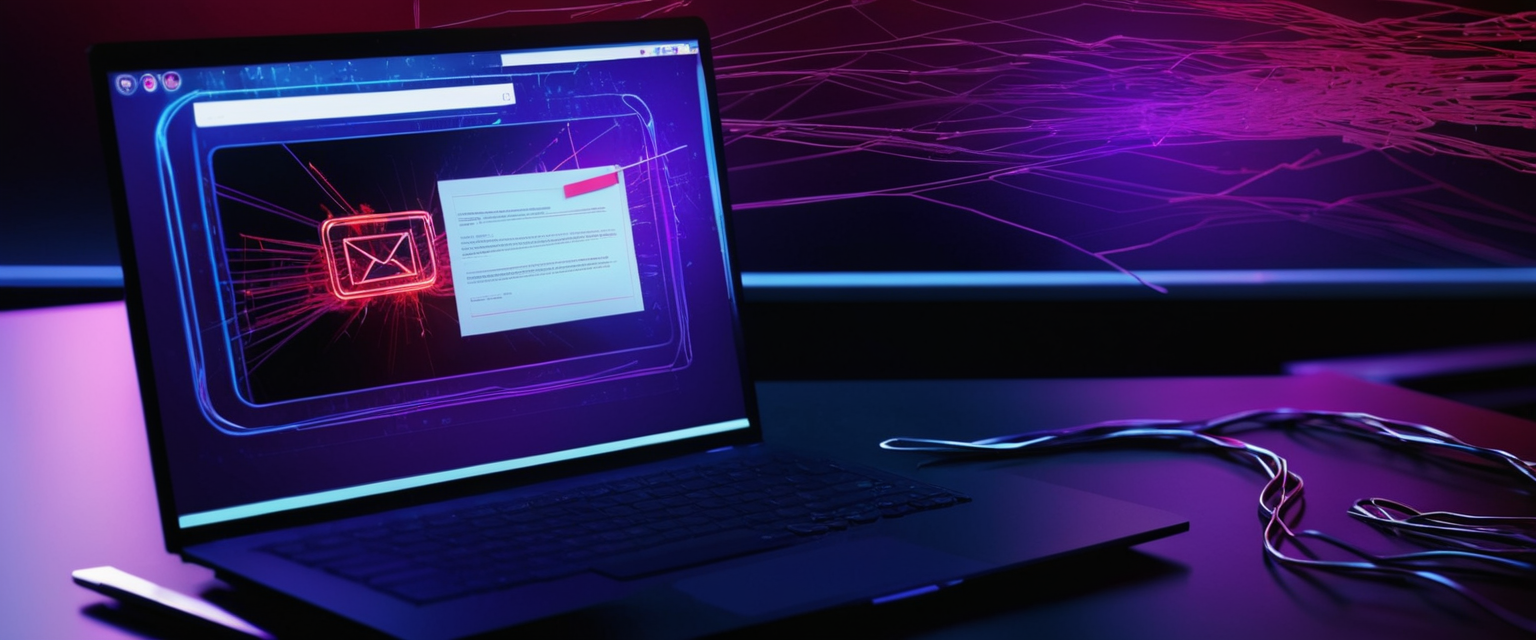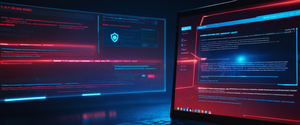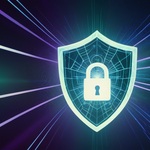
Email attachments represent one of the most critical and persistent vectors for malware distribution in contemporary cybersecurity threats, serving as the entry point for the majority of successful attacks against organizations and individuals worldwide. According to the 2024 Verizon Data Breach Investigation Report, 94% of all malware is delivered through email attachments, making this delivery method the overwhelming choice for cybercriminals seeking to compromise computer systems, steal sensitive data, and deploy ransomware across networks. While traditional security perimeters have improved significantly over the past decade, malware authors have responded with increasingly sophisticated techniques that exploit human psychology, leverage legitimate file formats, and employ multi-stage infection chains designed to evade detection by both automated security systems and human users. This comprehensive analysis examines the technical mechanisms, tactical approaches, evolving threat landscape, and defense strategies necessary to understand and mitigate the persistent threat posed by malware-laden email attachments.
The Email Attachment Threat Landscape and Prevalence
Email has maintained its position as the primary attack vector for malware delivery despite decades of security investment and awareness campaigns, a distinction that reflects both the ubiquity of email communication in modern business and the inherent trust users place in email as a communication medium. The sheer volume of malicious emails represents a fundamental challenge to cybersecurity infrastructure, with research indicating that approximately 3.4 billion phishing emails are sent daily, creating an enormous surface area for attackers to discover vulnerable targets. The persistence of email-based attacks stems from a combination of factors including the high effectiveness of social engineering tactics, the relative ease of spoofing legitimate sender addresses, and the continued reliance of organizations on email as their primary business communication tool. When attackers can exploit emotional triggers such as urgency, fear, or curiosity through carefully crafted messages containing seemingly legitimate attachments, they dramatically increase the likelihood that users will take the actions necessary to trigger malware execution. The human element remains fundamentally more exploitable than many technical security controls, particularly when users receive messages that appear to originate from trusted sources such as colleagues, financial institutions, or government agencies.
The prevalence of malware delivered through email attachments has not diminished with the advancement of security technologies, and recent research demonstrates that threats bypassing email filters have actually increased in recent years. Before training, only 34% of users successfully report phishing simulations with attachments, while an alarming 11% fail by opening the attachment or clicking malicious links, illustrating the continued vulnerability of the human component in security infrastructure. The trend of phishing attacks appears to follow patterns influenced by technological developments, with the advent of ChatGPT and other generative AI tools in 2022 corresponding with a significant surge in phishing attacks that bypassed traditional email filters. This connection suggests that as attackers gain access to more sophisticated tools for crafting convincing emails and social engineering lures, the overall threat volume increases correspondingly. Interestingly, the growth rate of successful phishing attacks appears to have moderated somewhat in 2024, with some research suggesting that email filters have adapted to better identify AI-generated phishing campaigns, yet the overall threat remains persistently elevated. The scale of this threat cannot be overstated, as each successful email attachment-based attack can serve as the entry point for comprehensive network compromise, data exfiltration campaigns, ransomware deployment, and advanced persistent threat activities that persist across months or years.
Common Malware Types Distributed Through Email Attachments
The landscape of malware delivered via email attachments encompasses diverse threat types, each with distinct mechanisms of infection and different objectives ranging from data theft to system encryption to unauthorized network access. Ransomware remains among the most devastating malware types deployed through email attachments, and this category has evolved considerably to employ more sophisticated targeting and monetization strategies. In many cases, ransomware is worse than general malware because the effects can be far more dire and far-reaching than a typical malware infection, and the critical difference lies in the fact that ransomware attacks are typically backed by organized malicious human actors who actively manage and execute attacks rather than simply deploying self-replicating code. Once ransomware reaches the encryption stage, victims often have limited options to reverse the worst effects, creating high-pressure situations where organizations face the difficult choice of potentially paying substantial ransoms to recover encrypted data. The rise of Ransomware-as-a-Service (RaaS) models has democratized ransomware deployment by allowing individuals without advanced technical expertise to launch attacks using rental tools available through underground forums and marketplaces, dramatically expanding the threat actor ecosystem.
Trojan horses represent another prevalent category of malware distributed via email attachments, including specific variants designed to harvest credentials, steal banking information, or establish remote access to compromised systems. The notorious Emotet botnet, which represented 19 percent of all reported malware attacks at its peak in 2020, commonly spread using malicious Word documents attached to emails, and this malware family demonstrates how attachments can deliver complex, modular payloads designed to execute multiple malicious functions. Emotet has most commonly spread using malicious Word documents attached to emails, and the prevalence of this delivery mechanism reflects the continued trust users place in Microsoft Office documents as legitimate business communications. Similarly, TrickBot was typically delivered via email campaigns that used current events or financial lures to entice users to open malicious file attachments or click links to websites hosting the malicious files, usually employing Excel or Word documents with malicious macro codes. The effectiveness of these approaches reflects a fundamental challenge in email security: distinguishing between legitimate Office documents containing only data and those containing embedded code designed to execute when the document opens.
Spyware and information-stealing malware represent another major category of threats distributed through email attachments, with these tools designed to covertly monitor user activity, capture sensitive information, and transmit stolen data to attacker-controlled infrastructure. PhantomVAI Loader has been observed delivering various infostealers including AsyncRAT, XWorm, FormBook and DCRat through phishing emails containing obfuscated JavaScript or VBS code, PowerShell scripts, demonstrating how threat actors combine multiple delivery mechanisms and programming languages to increase resilience and evade detection. The availability of these tools through underground markets as Malware-as-a-Service offerings has reduced barriers to entry for attackers, enabling even relatively unsophisticated threat actors to deploy professional-grade malware. Adware and other less severe malware types, while potentially less destructive than ransomware or banking Trojans, nonetheless cause considerable harm through system degradation, unauthorized data collection, and manipulation of user experience through unwanted advertisements and behavior.
File Types and Technical Mechanisms of Malware Delivery
The technical approaches used to embed and deliver malware through email attachments have evolved substantially in response to detection capabilities, with attackers continually developing new techniques to disguise malicious code within files that appear innocent or legitimate. Attackers frequently employ file types like .exe (executable files), .zip, .rar (compressed folders that may contain malicious content hidden within multiple layers), or .7z for their nefarious purposes, and these formats offer versatility in concealing malicious code and facilitating its execution upon user interaction. However, the diversity of file types capable of delivering malware extends far beyond simple executable files, as attackers have demonstrated the ability to weaponize nearly every common file format used in business communications. Macro malware hides in Microsoft Office files and is delivered as email attachments or inside ZIP files, using names that are intended to entice or scare people into opening them and often looking like invoices, receipts, legal documents, and this category of threats exploits the powerful automation capabilities built into Microsoft Office applications.
The distinction between traditional executable files and more subtle malware delivery mechanisms is crucial for understanding the breadth of the threat landscape. Traditional approach involves attaching direct executable files (.exe, .scr, .com files) to emails, but attackers have learned that modern email security systems and user training increasingly flag obviously suspicious executables, making detection easier. Instead, contemporary attacks increasingly focus on file types that users commonly receive as part of normal business operations, such as Microsoft Word documents (.doc, .docx), Excel spreadsheets (.xls, .xlsx), PowerPoint presentations (.ppt, .pptx), and PDF files. These document formats can contain macros—small programs embedded within the document that execute when the file opens or when a user enables specific features. In recent versions of Microsoft Office, macros are disabled by default, requiring malware authors to convince users to turn on macros so that their malware can run, often by showing fake warnings when a malicious document is opened. This social engineering component has become essential to the delivery mechanism, as attackers craft message content and fake warning dialogs designed to convince users that enabling macros is necessary for viewing the document’s contents.
Archive files such as ZIP, RAR, and 7z represent another critical file type used in malware distribution, offering attackers multiple advantages for concealing malicious payloads. File archive extensions such as .zip, .rar, or .7z are commonly used to hide malicious files from being scanned by email security and other systems, with the file often hidden in the attachment behind a password given to the recipient in the email. This technique exploits a fundamental limitation in email security scanning: traditional antivirus engines scan file contents to detect malicious code, but password-protected archives cannot be scanned without the password. By providing the password in the email body (or in a separate communication), attackers ensure that recipients can access and extract the archive contents while bypassing automated scanning that cannot penetrate the encryption. The archive may contain executable files, scripts, or document files with embedded code, all hidden from detection within the compressed container.
JavaScript and VBScript files represent particularly dangerous attachment types because these scripting languages can execute directly on Windows systems with minimal user interaction, yet they often appear innocuous to users unfamiliar with programming. The phishing email attachments in PhantomVAI Loader campaigns are archived JavaScript or VBS files that are obfuscated in an attempt to bypass detections, with the script embedding a Base64-encoded PowerShell script that executes to download and deliver the next stage of the infection. The multi-stage nature of contemporary malware delivery through script-based attachments reflects attackers’ understanding that distributing the complete malware payload in a single file increases detection risk. Instead, attackers commonly use initial script files as downloader components that retrieve subsequent payloads from internet-accessible servers, allowing them to modify or customize payloads based on the target victim or conditions at the time of execution.
PDF files have also become increasingly weaponized despite their reputation as relatively safe document formats. Phishing emails bearing PDF attachments remain a staple of both mass and targeted campaigns, with threat actors now favoring QR codes inside PDFs instead of embedding clickable links directly, making it substantially more difficult for both automated security systems and users to detect the malicious intent. The placement of QR codes within PDF attachments creates a particularly insidious attack vector because scanning QR codes typically occurs on mobile devices, which often lack the same enterprise-grade security controls as desktop workstations. This reflects a broader trend of attackers adapting their tactics to exploit gaps in the security posture of mobile devices and remote work scenarios.
Multi-Stage Infection Chains and Advanced Delivery Mechanisms
Contemporary malware distribution through email attachments frequently employs multi-stage infection chains rather than deploying complete malware payloads in initial attachments, a strategic approach that provides numerous advantages for attackers including reduced detection risk, increased flexibility, and the ability to customize payloads for specific targets. An attack chain observed in December 2024 employs distinct, multi-layered stages to deliver malware like Agent Tesla variants, Remcos RAT or XLoader through a phishing campaign using deceptive emails posing as an order release request with malicious attachments. The typical progression of these multi-stage attacks follows a consistent pattern: the initial attachment contains a downloader or loader component that communicates with attacker-controlled infrastructure to retrieve the next stage, which then retrieves and executes the final payload. This modular approach allows attackers to update their tactics rapidly, deploying different final payloads to different targets or modifying delivery mechanisms without requiring massive recompilation and redistribution of initial stage code.
A concrete example of this multi-stage approach involved a phishing email with an attached archive doc00290320092.7z containing a JavaScript file doc00290320092.jse that acts as a downloader designed to retrieve and execute a PowerShell script. When the victim extracts the archive and opens the JSE file, it executes a PowerShell script that has been minimally obfuscated, containing a Base64-encoded payload that it decodes, writes to the temporary directory, and executes. The analysis of multiple PowerShell payloads from different campaigns revealed that the next-stage payload varies between two types of files: either a .NET compiled executable or an AutoIt compiled executable, demonstrating how attackers employ multiple execution paths to increase resilience and evade detection. The .NET compiled executable contains encrypted payloads using either AES or Triple DES encryption, which once decrypted are injected into running processes such as RegAsm.exe to establish execution while hiding from direct observation. This technique of process injection represents a fundamental evasion mechanism where malware runs within the context of a legitimate Windows system process, making detection substantially more difficult for security tools relying on process execution monitoring.
The sophistication of contemporary infection chains extends beyond simple staging and includes techniques specifically designed to complicate both automated detection and manual analysis by security researchers. The AutoIt compiled executable introduces an additional option to the attack chain, further complicating detection and analysis, containing an encrypted payload that loads shellcode for the final malware stage, ultimately resulting in the injection of a .NET file into a RegSvcs process which in turn loads an Agent Tesla variant. This layering of different programming languages and execution contexts creates a particularly difficult challenge for security analysts attempting to trace the full attack chain and understand the complete infection mechanism.

Social Engineering and Psychological Manipulation in Attachment-Based Attacks
The delivery mechanism of email attachments inherently involves social engineering components because successful infection requires that a user perform an action—typically opening an attachment—that results in malware execution. Threat actors have developed increasingly sophisticated psychological manipulation tactics designed to exploit human behaviors such as fear, curiosity, urgency, and trust in authority figures. Attackers use social engineering tactics to trick users into opening them, including phishing emails mimicking trusted sources like banks, government agencies, or major e-commerce platforms, urging recipients to click on links or download attachments that trigger malware downloads and execution. The effectiveness of this approach reflects fundamental human psychology: when individuals receive messages from sources they believe to be legitimate, containing plausible reasons for action, and framing that action as urgent or important, they experience cognitive dissonance that often leads to compliance.
Contemporary phishing emails employ multiple layers of deception designed to overcome both technical and user-based defenses. Emails containing themes like sales, payments and legal actions are used to trick targeted users into opening the malicious attachment, exploiting the reality that most users do engage with legitimate business communications on these topics. The presentation of attachments often mimics legitimate business documents, with filenames designed to appear innocuous or even important—for example, names like “Invoice_2024_Q3.xlsx” or “Tax_Document_2023.pdf” that suggest routine business documents. When users receive such attachments from email addresses that appear to be from colleagues, management, or trusted business partners (through email spoofing), the social engineering component becomes particularly effective.
Fear-based social engineering represents another powerful tactic employed in phishing campaigns, with attackers leveraging urgency and threats to override careful consideration. Attackers use fear tactics by threatening account closures or legal actions unless immediate steps are taken, including opening an attachment, creating artificial time pressure that leads users to act quickly without verifying the legitimacy of the request. The effectiveness of fear-based approaches reflects the reality that many users have experienced legitimate account security incidents or legal issues, making such threats credible enough to trigger compliance. Similarly, attackers may impersonate IT help desk personnel or security teams, claiming that immediate action is required to address a security issue, verify account information, or confirm identity, with the malicious attachment or link positioned as the method for completing the required action.
Attachment-Based Threats in Business Email Compromise and Advanced Attacks
Business Email Compromise (BEC) attacks represent a particularly insidious variant of attachment-based malware delivery where attackers compromise or spoof legitimate business email accounts to deliver malicious attachments with dramatically increased credibility. BEC attacks involve compromising legitimate email accounts belonging to employees within an organization and using them to send convincing emails with malicious attachments to other employees, partners, or clients, and the increased trust placed in internal communications dramatically reduces skepticism and increases infection likelihood. The challenge for users and security systems in identifying BEC attacks stems from the fundamental legitimacy of the sender address, which appears in the recipient’s address book and may have a history of previous communications. When malicious attachments arrive through apparently compromised internal accounts, users face a substantially higher trust threshold than when receiving suspicious emails from external sources.
The sophistication of advanced persistent threat (APT) actors targeting specific organizations represents the highest end of attachment-based malware delivery, with these threat actors employing extensive reconnaissance and customized attacks designed to maximize success rates for high-value targets. Mustang Panda, Naikon, OilRig, and numerous other nation-state and criminal APT groups have used spearphishing attachments to deliver initial access payloads targeting specific organizations, with these campaigns carefully tailored to specific industries, organizations, and sometimes even individual employees. APT-attributed attacks involving attachments frequently employ zero-day vulnerabilities or previously unknown malware variants that have not been analyzed by the security research community, giving these campaigns substantially higher likelihood of successful infection compared to mass phishing campaigns using known malware. The targeting precision of these attacks reflects significant investment in reconnaissance and planning, with attackers gathering intelligence about organizational structure, employee roles, business processes, and technical environment to maximize attack effectiveness.
Detection Evasion and Advanced Technical Tactics
Contemporary malware delivered through email attachments employs sophisticated evasion techniques specifically designed to bypass both technical security controls and human-operated security analysis. Malware is becoming more adept at evading detection using techniques like polymorphism (changing its code) and living off the land (using legitimate system tools for malicious purposes), with polymorphic malware changing its code on each execution to avoid signature-based detection. The concept of “living off the land” reflects attackers’ strategic use of legitimate Windows utilities and features that are typically trusted by security systems and endpoint users, such as PowerShell, Windows Management Instrumentation (WMI), or legitimate system administration tools that can be repurposed for malicious activities.
Obfuscation and code encoding represent fundamental evasion techniques employed in contemporary malware attachments, with attackers extensively encoding malicious code to make it unrecognizable to both automated security scanning and human analysis. JavaScript or VBScript files use Base64 encoding to conceal PowerShell scripts, with the obfuscated scripts attempting to bypass detection by disguising malicious commands as legitimate system operations. The use of multiple layers of encoding—where encoded payloads are further encoded or encrypted—creates a particularly challenging scenario for security analysts attempting to understand the infection mechanism. Some advanced malware implementations employ steganography techniques, hiding malicious code within image files or other data containers that appear innocuous to casual inspection but contain embedded payloads when examined by the malware’s decompression and extraction routines.
The exploitation of legitimate services and tools represents an increasingly common evasion approach that directly addresses a fundamental gap in traditional perimeter security. E-signature platforms were heavily abused for malware delivery in 2024, with DocuSign being the most abused e-signature service and used to send malicious emails and attachments, exploiting users’ trust in DocuSign as a legitimate business communication platform. This approach reflects attackers’ strategic understanding that security systems and users alike develop trust in well-known, legitimate services and may apply lower security scrutiny to communications originating through these channels. The abuse of legitimate services creates a particular challenge for defenders because conventional approaches of blocking suspicious domains or services would necessitate blocking legitimate business services, creating unacceptable operational friction.
Zero-Day and Advanced Vulnerability Exploitation in Attachments
While many attachment-based malware campaigns exploit known vulnerabilities or user behavior, advanced threat actors frequently leverage zero-day vulnerabilities—security flaws unknown to software vendors and the security research community—to achieve more reliable infection rates and higher success probabilities. Threat actors exploited a Zimbra zero-day vulnerability CVE-2025-27915 in attacks using malicious iCalendar (.ICS) files to deliver JavaScript payloads to targeted systems, exploiting improper HTML sanitization in ICS files that allowed JavaScript to execute via an
The Libraesva Email Security Gateway vulnerability CVE-2025-59689 represents another example of zero-day exploitation specifically targeting email attachments, with suspected state-sponsored attackers exploiting a command injection vulnerability caused by improper sanitization when removing active code from files inside certain compressed archive formats, triggered by emails containing specially crafted compressed attachments. This vulnerability represents a particularly sophisticated attack surface because it targets email security infrastructure itself, allowing attackers to bypass security controls intended to protect organizations against malicious attachments. State-sponsored attackers specifically targeting email security gateways demonstrates the strategic importance these actors place on defeating email-based defenses, and indicates that the evolution of attack capabilities continues to outpace many organizations’ defensive postures.

Ransomware Deployment Through Email Attachments
Ransomware represents perhaps the most financially and operationally destructive malware category deployed through email attachments, with these attacks targeting organizations across all industries and producing direct financial losses, business interruption costs, and long-term reputational damage. Ransomware is often spread through phishing emails that contain malicious attachments or through drive-by downloading, with drive-by downloading occurring when a user unknowingly visits an infected website and malware is downloaded and installed without the user’s knowledge, though the attachment-based delivery remains the most prevalent mechanism. The REvil ransomware group has been widely observed deploying ransomware through malicious email attachments, with this group demonstrating the sophistication and scale of ransomware operations backed by organized criminal enterprises. The business model of ransomware operators increasingly emphasizes targeting selection and customization, with threat actors focusing attacks on specific industries and organizations deemed more likely to possess both valuable data and sufficient resources to pay substantial ransoms.
The financial impact of ransomware attacks initiated through email attachments extends far beyond the direct ransom demands, encompassing incident response costs, business interruption losses, regulatory penalties, credit monitoring services for affected individuals, and long-term reputation damage. In 2024, the average cost of a phishing breach was $4.88 million, up 9.7% from 2023, and given that phishing remains the primary initial access vector for ransomware attacks, this figure represents a substantial portion of the total cost of ransomware incidents. Some organizations have reported ransomware incident response and recovery costs exceeding $50 million for large-scale attacks, particularly when dealing with critical infrastructure or significant data exposure scenarios.
The Role of Multi-Factor Authentication Bypass in Attachment-Based Attacks
The increasing deployment of multi-factor authentication (MFA) as a security control has driven attackers to develop sophisticated techniques for bypassing these protections, with modern phishing campaigns increasingly focusing on MFA credential theft rather than single-factor passwords. Live-proxy techniques have been adopted by phishers to steal one-time codes, with emails impersonating a cloud storage provider inviting users to review service quality and redirecting to look-alike domains that proxy all interactions to the real service via API calls. This approach represents a particularly dangerous evolution in phishing tactics because it maintains the high-fidelity mimicry of legitimate services that naturally builds user trust while simultaneously capturing real-time MFA codes. When victims interact with the fraudulent login page, the attackers’ infrastructure relays their inputs to the legitimate service, receives the real authentication challenge, relays that to the victim, captures the MFA code when the victim enters it, and then uses both the password and the MFA code to access the real account—all while the victim believes they are interacting with a legitimate service.
Once the victim inputs the code—believing they are interacting with the legitimate service—the phishers obtain both the password and the dynamically generated second factor, granting them full account access, and this complete account compromise enables attackers to maintain persistent access and potentially pivot to more sensitive systems. The sophistication of these MFA bypass techniques reflects the strategic importance attackers place on email account access, recognizing that gaining control of organizational email accounts enables business email compromise attacks against other employees, customers, and partners.
Industrial Trends and Emerging Threats in 2024-2025
The contemporary threat landscape for email attachment-based malware reflects rapid evolution driven by advances in artificial intelligence, availability of commoditized cybercrime tools, and increasing sophistication of both attackers and defender technologies. In 2025, attackers are employing tried-and-true approaches like password-protected attachments and calendar invites with new twists such as QR codes, multi-stage verification chains, and live API integrations, demonstrating how classical attack techniques continue to evolve and adapt to contemporary security controls. The resurgence of calendar-based phishing represents a particularly interesting development, with attackers leveraging calendar invite functionality to deliver malicious links that victims interact with days after the initial email, potentially after they have forgotten the context and lowered their skepticism toward the communication.
QR code-based phishing in email attachments represents one of the most significant emerging threats, as QR codes inside PDFs shift phishing URLs behind an extra layer of file handling, with recipients scanning codes on mobile devices that often lack the same enterprise-grade security controls as workstations. This development directly addresses a fundamental detection gap in email security systems: most email filtering and detection systems scan URLs within email content to identify phishing links, but they cannot easily scan or analyze QR codes embedded within image files. The shift to QR codes thus represents a tactical innovation specifically designed to exploit the limitations of contemporary email security infrastructure. Additionally, the prevalence of mobile device usage in contemporary workplaces means that many users receive and interact with emails on their phones, where security context is often reduced and warnings about suspicious content less prominent.
The incorporation of generative AI technologies into phishing campaign development represents a transformative shift in the threat landscape, with AI significantly reducing the barriers to entry for creating convincing phishing emails and enabling rapid customization of campaigns for different targets. AI takes just a few seconds to generate emails that seem totally legit (as opposed to “traditional” phishing emails with typos and weird syntax which look suspicious up front), and this capability addresses what has traditionally been a distinguishing factor between mass-market phishing and targeted spear-phishing campaigns. The ability to generate grammatically correct, contextually appropriate phishing emails at scale removes what has been a significant filtering heuristic—namely, identifying phishing emails by their poor grammar, spelling errors, and inconsistent tone. Security teams that have relied on user training to identify obviously suspicious phishing emails due to poor grammar now face a landscape where AI-generated attacks are often indistinguishable from legitimate communications.
Defense Strategies and Email Security Controls
Organizations implementing comprehensive defense strategies against email attachment-based malware must employ multi-layered approaches recognizing that no single security control provides complete protection. Secure email gateways filter out unsafe email traffic including spam, phishing emails, and dangerous email attachments, with many including anti-malware scanning capabilities enabling them to identify malware inside attached files while maintaining lists of known threats and blocking all emails from them. However, the limitations of email gateway-based defenses must be recognized, as secure email gateways are not a guarantee against email attachment-based attacks, with new types of malware not being detected, emails sent from trusted or unknown sources not being blocked, and even known malicious content sometimes getting through defenses. This reality necessitates additional defensive layers beyond perimeter controls.
Advanced attachment sandboxing represents a critical defensive technology specifically designed to address the limitations of signature-based malware detection. Attachment sandboxing uses advanced sandbox technology to quarantine harmful email attachments that can evade other antivirus or anti-spam software, even identifying malware and viruses that are brand new and never seen before. The sandboxing process involves extracting attachments from emails before they reach users and executing them within an isolated virtual environment where their behavior can be monitored without risking actual systems. Safe Attachments in Microsoft Defender for Office 365 uses a virtual environment to check attachments in email messages for harmful attachments before they’re delivered to recipients through a process known as detonation, typically completing within 15 minutes. The benefit of sandboxing extends beyond simple detection because security tools can observe malware behavior and identify previously unknown malware variants that may not have signatures in traditional antivirus databases.
File type filtering and blocking represents a more aggressive approach to attachment security where organizations restrict the file types that can be transmitted through email or require special handling for potentially dangerous extensions. Organizations can set filtering rules to block risky email attachment types including dangerous file extensions such as .exe, .scr, .vbs, .rtf, .doc, .xls and numerous others that have little legitimate reason to appear in email communications. Additionally, many organizations implement policies that block double extensions (such as “report.pdf.exe”) that rely on file extension spoofing to deceive users into trusting executables that appear to be document files. The effectiveness of file type filtering depends on understanding which attachment types carry the highest risk, and this understanding must continuously evolve as attackers develop new approaches to deliver malware through unexpected file types.
User education and security awareness training represents an essential component of attachment security defenses, though the effectiveness of such training varies substantially based on implementation approach and the sophistication of attacks. Before training, only 34% of users successfully report phishing simulations with attachments, while an alarming 11% fail by opening the attachment or clicking malicious links; however, after 12 months of phishing training, Hoxhunt sees success rate more than double from 34% to 74% at 12 simulations and climbs to 80% after 14 simulations, with failure rate plummeting by 5.5x from 11% to below 2%. This dramatic improvement following structured, ongoing security awareness training demonstrates that behavior change is achievable when organizations invest in proper training mechanisms. Additionally, adaptive phishing training shows that the notable improvement in users at spotting and reporting simulated malicious attachments demonstrates pronounced behavior change with reporting rates and malicious clicks declining significantly compared to other types of simulated attack types.

Regulatory and Organizational Response Frameworks
Organizations implementing comprehensive email security programs must establish clear policies, procedures, and accountability structures for handling potentially malicious attachments and responding to detected threats. Organizations should develop and maintain incident response plans outlining steps to take in the event of successful email-based attacks, with these plans specifying roles and responsibilities, escalation procedures, communication protocols, and recovery procedures. The incident response plan should specifically address email attachment-based incidents, establishing procedures for isolating affected systems, conducting forensic analysis to determine the extent of compromise, remediating vulnerabilities that enabled infection, and restoring systems and data from clean backups.
Email authentication protocols such as Sender Policy Framework (SPF), DomainKeys Identified Mail (DKIM), and Domain-based Message Authentication, Reporting, and Conformance (DMARC) provide foundational mechanisms for verifying email sender authenticity and preventing email spoofing. Organizations should implement email authentication protocols such as SPF, DKIM, and DMARC to verify the authenticity of email senders and reduce the likelihood of spoofed or fraudulent emails, addressing one of the fundamental social engineering tactics used to increase trust in phishing emails. When these authentication mechanisms are properly configured and enforced, they substantially reduce the likelihood that attackers can successfully spoof emails from trusted domains, though sophisticated attackers may focus their efforts on other tactics such as compromising legitimate email accounts to send attacks through authenticated channels.
Organizations should establish clear policies regarding acceptable email attachment types, with many implementing blanket blocks on potentially dangerous files while allowing legitimate business needs through controlled exception processes. Organizations should restrict the types of file attachments users can send and receive via email, considering blocking potentially dangerous file types such as executable files (.exe), script files (.js, .vbs), and compressed archives (.zip, .rar) commonly used to distribute malware, though the specifics must reflect organizational needs and security posture. Additionally, organizations may implement policies requiring users to request permission or provide business justification before sending or receiving attachment types that carry elevated risk, creating a human review checkpoint in the process.
Closing the Door on Attachment-Borne Malware
Email attachments will almost certainly remain the primary vector for malware distribution for the foreseeable future, as the fundamental combination of factors enabling this attack vector—the ubiquity of email communication, the trust users place in email, the ease of spoofing legitimate senders, and the powerful capabilities embedded in modern file formats—are unlikely to change substantially in the near term. The escalating sophistication of attachment-based attacks, including the incorporation of artificial intelligence into phishing campaign development, the deployment of multi-stage infection chains designed to evade detection, and the targeting of email security infrastructure itself through zero-day exploits, indicates that the threat landscape will continue to evolve more rapidly than many organizations’ defensive capabilities. Organizations that recognize email attachment security as a foundational priority and invest comprehensively in both technical controls and human-centered security awareness training will achieve substantially better protection than those treating attachment security as a secondary concern.
The most effective organizational posture toward email attachment-based malware involves recognition that no single security control provides complete protection, necessitating defense-in-depth strategies that layer multiple controls including email gateway security, advanced attachment sandboxing, file type filtering, endpoint detection and response, user education, and incident response capabilities. The data clearly demonstrates that well-trained security-aware employees represent a critical component of this layered defense, with comprehensive security training programs reducing failure rates on malicious attachment interactions by 5.5x over twelve months. However, organizations must simultaneously recognize that social engineering tactics will continue to evolve and that even extensively trained users will occasionally fall victim to particularly sophisticated attacks. Therefore, technical controls must assume that some percentage of users will interact with malicious attachments, and endpoint and network-based detection capabilities must focus on identifying and containing infections after user interactions occur.
Looking forward, organizations should anticipate continued evolution in email attachment-based attacks including increased leveraging of artificial intelligence for phishing email generation, expanded use of zero-day vulnerabilities targeting email systems and security infrastructure, and innovative abuse of emerging communication platforms and file formats. The landscape of threats delivered via email attachments represents a fundamental cybersecurity challenge that will persist as long as email remains a primary business communication vector. Organizations that maintain awareness of contemporary threat tactics, invest in appropriate security controls, establish clear policies and procedures, and most importantly foster a strong security culture within their workforce will achieve substantially better protection against this persistent and evolving threat.
Protect Your Digital Life with Activate Security
Get 14 powerful security tools in one comprehensive suite. VPN, antivirus, password manager, dark web monitoring, and more.
Get Protected Now





